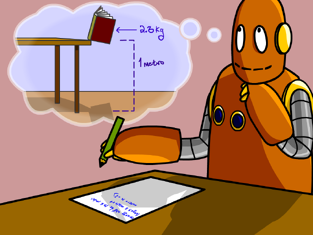| Potential Energy | |||
|---|---|---|---|
 | |||
| Season | 6 | ||
| Episode | 6 | ||
| Airdate | March 19, 2002
Update: May 31, 2021 | ||
| Curriculum | Science | ||
Potential Energy launched in BrainPOP Science March 19, 2002.
Summary[]
Moby repeatedly destroys his mason jar collection. Tim discusses potential energy.
Update[]
The unused clip at the end has Tim saying "Cut it out."
Appearances[]
- Tim
- Moby
- Tim's Father (voice only)
Transcripts[]
Quiz[]
- Potential Energy/Quiz
Quotes[]
Update[]
Trivia[]
Tim's clip "Cut it out" is unused in the old version. Tim says this in the update.
FYIs[]
Personalities[]

As you may be aware, potential energy (in addition to kinetic and several other different types of energy) is measured in units called joules. But you probably don’t know about the guy the unit is named after, British physicist James Prescott Joule (1818-1889).
Joule was the son of a wealthy beer brewer and served as manager of his family’s brewery until the business was sold in 1854. After being tutored by the famed scientist John Dalton, the teenaged Joule developed an interest in electricity. His first papers explored this new field.
Soon, Joule came to realize that mechanical energy and heat energy were basically the same thing. This discovery contradicted the accepted scientific wisdom of the time. It was known as the “mechanical equivalent of heat,” kind of a fancy way of saying “it takes x amount of mechanical work to produce a change in temperature of y.”
Joule had trouble gaining acceptance for his ideas. However, in a famous experiment, he proved that you could raise the temperature of a barrel of water by spinning a paddlewheel inside it. Over time, more and more physicists came to realize that Joule was right.
He later worked with William Thomson, a.k.a. Lord Kelvin, to make more important discoveries about energy. After he died, his tombstone was inscribed with the number 772.5, his calculation of how many foot-pounds of force it took to raise the temperature of water by one degree Fahrenheit.
In Real Life[]

In the movie, Tim mentions that the higher he and Moby climb on the cable car, the more potential energy they will accumulate. This is due to a phenomenon called gravitational potential energy. Read on, and we'll tell you how it works.
Gravitational potential energy is the energy that an object possesses due to its position in a gravitational field. On Earth, this energy is completely dependent on the mass of an object and its position relative to the Earth's surface.
Thus, when Tim and Moby climb on the cable car, their potential energies will increase at the same rate. But no matter how high they rise, Moby's gravitational energy will always be greater than Tim's, as Moby is a 700kg metal robot and Tim is a 50kg
teenager. For example, Cati and Rita weigh about the same. So if the two are in a room on the second floor of the school, their gravitational potential energy will be the same. However, if Cati is in a room on the first floor, while Rita is in a room on the second floor, Rita will have greater potential energy.
Did You Know?[]

Here are some different types of potential energy!
Elastic potential energy is the amount of energy stored by an elastic object under tension. It’s found in things like springs, bows, and catapults. All of these objects are capable of doing work because of the elastic potential energy stored within them.
Chemical potential energy refers to the amount of energy held in any substance. It’s often related to the chemical bonds that hold the molecules of the substance together, and can be changed into other forms of energy through chemical reactions. A car is able to run because of the chemical potential energy of gasoline. When gasoline is burned, the bonds that hold its molecules together are broken and heat energy is produced. This causes the pistons in the engine to fire, which makes the car’s wheels turn.
Electric potential energy is the energy a particle has due to its position within an electric field. To bring two negatively charged particles together, work has to be done to overcome the electrical forces that repel them. To separate two oppositely charged particles, work has to be done to overcome the forces that pull them together. The amount of work that must be done to move an electrically charged object around represents its electrical potential energy.
Nuclear potential energy is contained within atomic nuclei. The fission reactions harnessed by nuclear power plants produce tremendous amounts of energy. This energy comes from breaking apart the powerful forces that hold the particles within atomic nuclei together. In their “unbroken” state, these atomic nuclei contain nuclear potential energy.
Do It![]

In one of the previous contents of the Trunk, we talked about gravitational potential energy: the potential energy that an object has by virtue of its mass and its position relative to the earth's surface. As it turns out, there is an easy way to calculate the difference between the potential energies of two near-Earth surface objects. The formula is expressed more or less like this:
Gravitational potential energy (in joules) = mass (kilograms) x g x h (meters), where g is the acceleration of gravity, or approximately 9.8 meters/second/second.
So if two 2 kg books are located directly on the Earth's surface, their gravitational potential energy is essentially 0. However, if they are raised and placed on a table one meter high, their gravitational potential energy will be 19.6 joules (2 kg x 9.8 m/s/s x 1 meter = 19.6 J).
With that in mind, answer the following questions. To make things easier for you, round the value from 9.8 g to 10 m/s/s.
1. What is the gravitational potential energy of a 3 kg object on the roof of an office building 18 m above the Earth's surface?
2. What is the gravitational potential energy of a 12 kg object located at the top of a 7-meter-high cliff?
3. Which object has the most gravitational potential energy: one of 15 kg located at 12 meters high, or another of 22 kg located at 4 meters high?
4. What is the gravitational potential energy of a 9 kg goose flying 72 m above the Earth's surface?
Answers: 1) 540 J; (2) 840 J; (3) the object of 15 kg; 4) 6,480 J
FYI Comic[]

